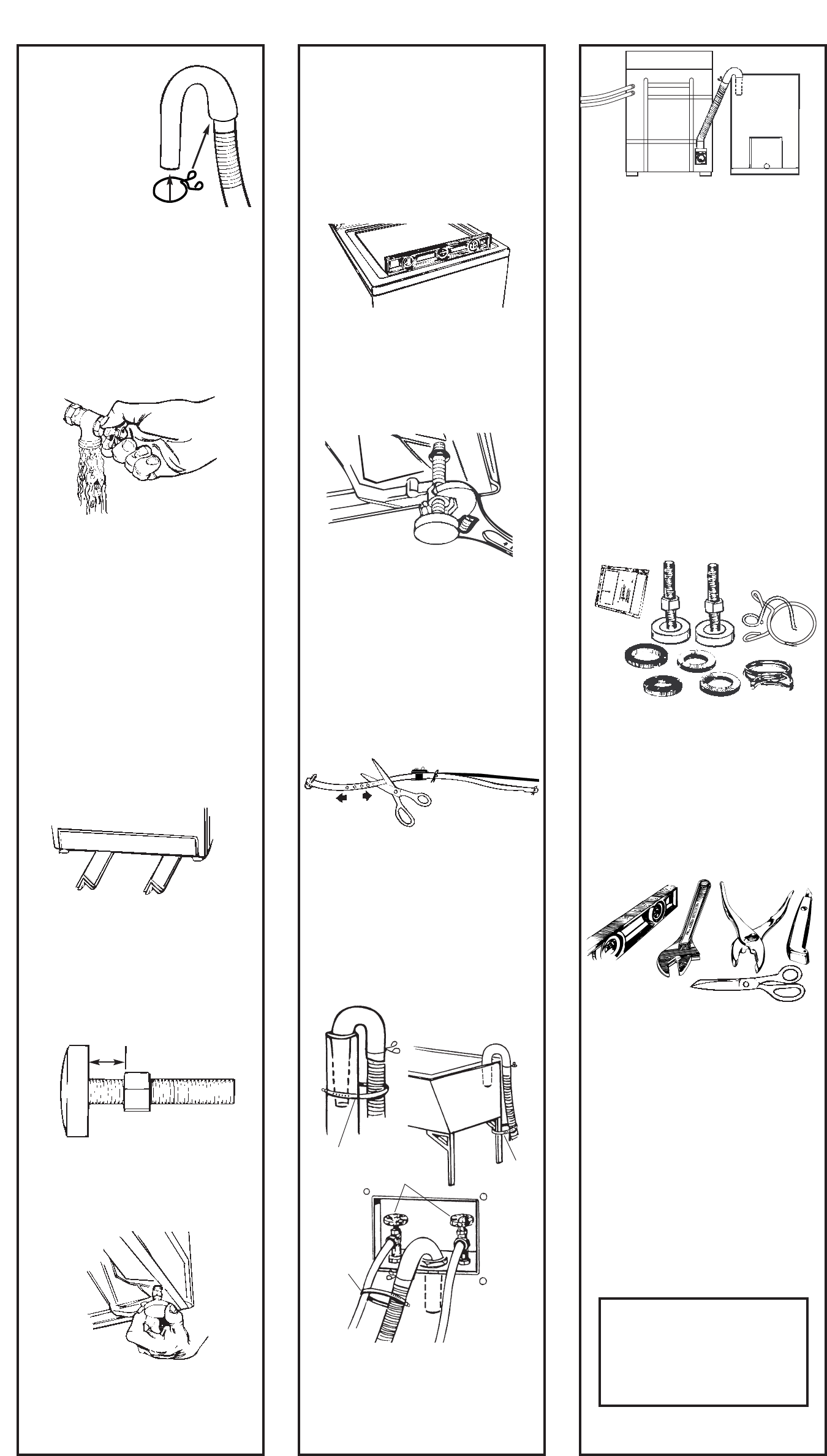
11.Insert legs into correct holes
at each front corner of washer until nuts
touch washer.
Do not tighten nuts until Step 14.
10.Use legs and nuts from parts
package. Screw nut down to within 1.3 cm
(1/2") of base.
1.3 cm
(1/2")
Nut
Base
9.Stack two corner posts on top of
each other and postion them 3 inches from
each side of the washer. Grasp the top,
front corners of the washer and tilt
backward until bottom, front of washer is
7.5-10 cm (3-4 inches) off the floor, and
slide corner posts under washer as shown.
6.Slide washer onto cardboard or
hardboard. Move washer close to final
position. Put “hook” end of drain hose into
laundry tub or standpipe. Check for proper
length of drain hose.
DO NOT FORCE EXCESS LENGTH OF
DRAIN HOSE DOWN THE STANDPIPE.
THIS COULD CAUSE SIPHONING.
8.Attach bottom hose (inlet
marked “H”) to hot water faucet. Attach
top hose (inlet marked “C”) to cold water
faucet. Tighten couplings to faucets by
hand, then use pliers to make final two-
thirds turn.
Strap
Strap
D
20.Untape power supply cord
and plug grounded outlet.
21.Take a few minutes and
read the Use and Care Guide to fully
understand your new KitchenAid washer.
Now start the washer and allow it to
complete the regular cycle.
15.After strap has been
removed from washer, measure and
mark a point approximately 38.1 cm (15")
from the plug end of the shipping strap.
Cut the shipping strap at this point.
Remove power supply cord plug from
strap.
Check that hose is not twisted or
kinked and is securely in place.
18.Turn on water faucets and
check for leaks. Tighten couplings if there
is leaking. Do Not overtighten, this could
cause faucet damage.
17.Check that all parts are
now installed. See parts list, Panel B. If
there is an extra part, go back through
steps to see which step was skipped.
16.CHECK ELECTRICAL
REQUIREMENTS. BE SURE YOU HAVE
CORRECT ELECTRICAL SUPPLY AND
RECOMMENDED GROUNDING
METHOD.
If longer drain hose is needed, drain hose
(Part No. 388423) and hose extension kit
(Part No. 285442) are available from
authorized parts distributors. If drain hose
must be shortened, use hose kit (Part No.
285442).
Check that hose is not
twisted or kinked and is
securely in place.
Note: If washer is moved to adjust drain
hose, the washer must be leveled again.
Repeat Steps 13-14. Place cardboard or
hardboard under the washer and
carefully move washer to avoid
damaging floor covering.
B
C
Strap
If drain hose cannot be strapped in place,
it must be of exact length so the “hook”
end is held tightly over the edge of the
tub or standpipe. Figure D.
19.
Check that you have all of your tools. Check
that the shipping strap with 2 cotterpins and
plug was removed from the back of the
washer and used to secure the drain hose.
13.Tilt washer forward, raising
back legs 2.5 cm (1") off of floor to adjust
rear self-leveling legs. Gently lower
washer to floor. Check levelness at the
washer front and from front to back on
each side, using a carpenter’s level.
A
NOTE: Use shipping strap to secure
drain hose. Water pressure could cause
drain hose to come out of standpipe or
laundry tub if drain hose is not secured.
When washer is level, use wrench to
turn nuts on front legs up tightly
against washer base. If nuts are not
tight against washer base, the washer
may vibrate.
14.
If washer is not level, screw the front legs
up or down to adjust. Make final check
with level.
38.1 cm
(15")
Use outside corners of the
cabinet to move washer to its
final location. Remove
cardboard or hardboard from
under washer.
12.Grasp top front corners to
tilt washer backward and remove corner
posts. Gently lower washer to floor.
5.Open clamp
and slide over “hook”
end of drain hose to
secure the rigid and
corrugated sections
together.
Check inlet hoses periodically. Replace
inlet hoses if you find bulges, kinks, cuts,
wear or leaking. Replace inlet hoses
after five years.
Hot and cold
water faucets
Put “hook” end of drain hose in tub or
standpipe. Tightly wrap the shipping strap
around the drain hose and standpipe or
tub leg and drain hose as shown in
Figures A-C. Push plug into the nearest
hole in the shipping strap.
PANEL C
C
H
7.Before attaching water inlet
hose, run water through both faucets
into a bucket. This will get rid of particles
in the water lines that might clog hoses.
To get the most efficient use
from your washer, read your
KitchenAid Use and Care
Guide. Keep Installation
Instructions and Guide close
to washer for easy
reference.
Slide washer onto cardboard or hardboard
before moving across floor.











